Brain Breaks For Kids
Brain Breaks For Kids
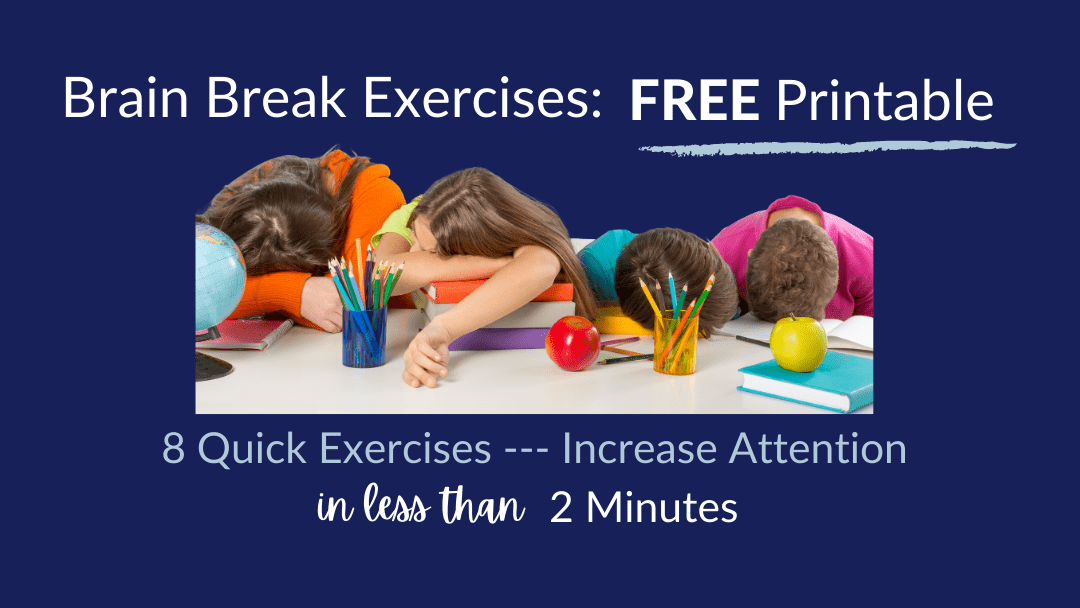
50 Educational Brain Breaks
It’s easy and quick to give your kids an energy boost, focus, and brain stimulation.
Looking for movement ideas for your kids? Sanford Fit offers hundreds of resources, including brain breaks, videos, lessons and other materials, to support kids in making healthy decisions inside and outside the school environment.
Whether kids are learning at home or in the classroom, it’s important to build time into schedules for brain breaks. Perhaps they just need to move. They might just want to stay still and have a rest.
Studies show that children who are given frequent brain breaks can improve their focus and ability to retain information. These are our top 50 educational brain breaks. They will increase your productivity and provide your children with a well-deserved break. Most of the above can all be done independently and safely if you keep at least 6 feet between your learners.
You can find so many educational brain breaks. Sanfordfit is a wonderful free resource. Just click “Let’s Get!” to access three moves for kids that are designed to help them get moving. Easy-to-print cards provide dozens action-packed mental breaks.
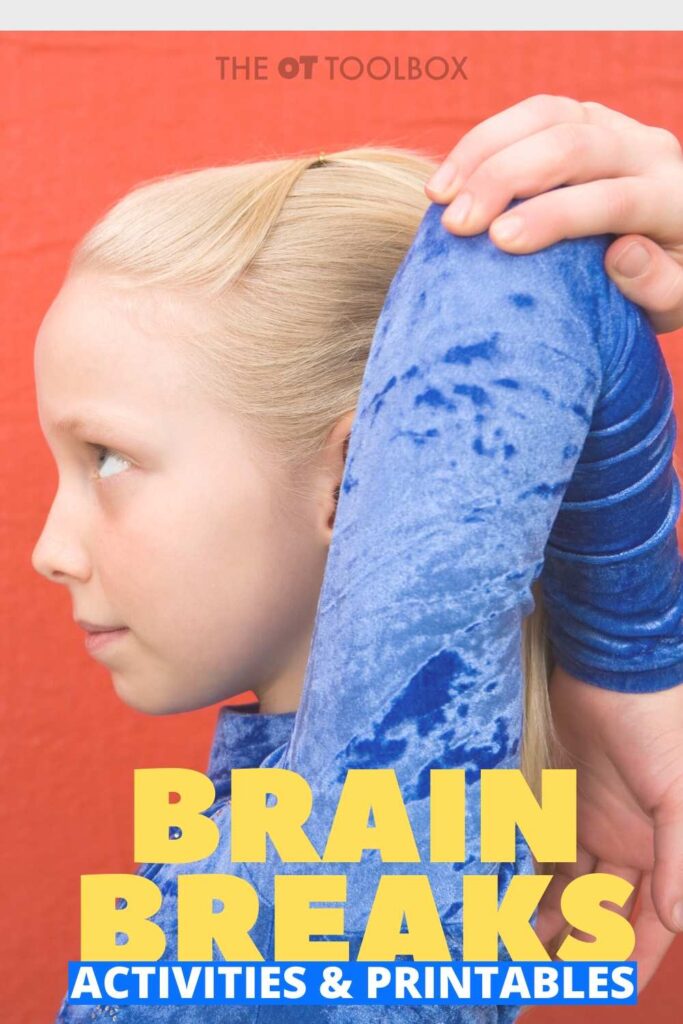
16. 6.Energize in 5, 3, 3, 2, 1.
You can get hearts racing with this quick sequence of activities. For your students, you can list 5 exercises that they should complete in as little time as possible. Example: 5 jumping jacks with 4 push-ups. 3 situps. 2 jump jumps. One tree pose.
Use sign language to teach your kids the alphabet. You can practice brain breaks by singing and signing the ABCs. Then, use brain breaks to practice vocabulary words. Spell them out loud as you sign the letters.

28. 28.
A great escape when things are getting a bit intense is comedy. A funny clip can be shown or children may volunteer to make a joke, or even pose silly riddles.
Color-in has become a very popular activity for grownups. It is an easy way to get calm and let go. Play some soothing background music and set a timer. Then, hand out these 30 positive self-talking coloring pages. Make a brain break spinner How to Make a Brain Break Spinner How’s this for a brain break during the day? How to make a brain break spinner
One way to make sure educational brain breaks are effective is to change up activities. Check out this step-by-step video from Sanford fit that shows you how to make your own Wheel of Fortune-type game to help you add variety to brain breaks!
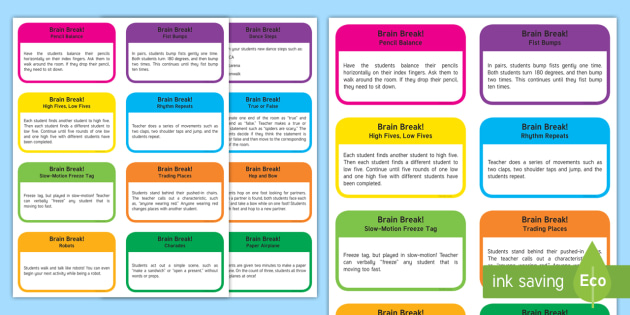
50 50.
Your child can use your desk, chair or side of the couch. When they are ready, have them put their hands on the tables and look at the center. Slowly move down then back up.
Do you like educational brain breaks?
Sanfordfit has some of the best brain-break ideas you can use at school or home.
Get ready for 2021-22 by stocking your classroom $140,000 for teacher prizes
Register to Win>
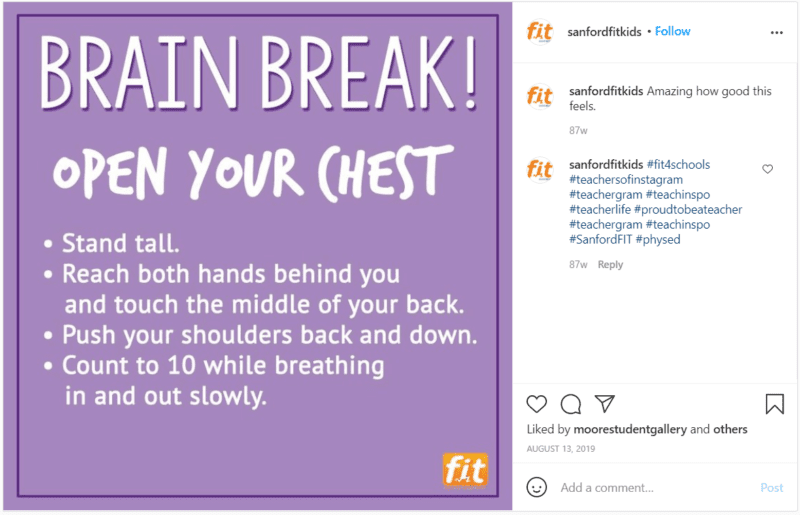
What Are
50 Educational Brain Breaks
Children can use brain breaks to get mental rest between their learning activities.
You can use them at school, at home or during your homework. You can choose to make these activities active or passive, according to what each child needs.
Photo by Ketut Subiyanto The purpose of brain breaks is to switch neural activity to different networks.
While kids work, most energy flows to brain areas that support attention and critical thinking. Brain breaks help to reset these brain areas and increase learning, reducing stress and improving performance when children return to their task.
Brain breaks often focus on physical movement, mindfulness or sensory activities. These activities stimulate other areas of the brain that are equally important, but aren’t used as much when kids are working and learning.
Most important, brain breaks are:
Ideal time is between 3-5 and 5 minutes.

Skill-Building Brain Breaks For Kids
Children still have the ability to learn and acquire new skills through these brain breaks. Your brain can still take a rest if you shift the focus to another activity.
Tip: You can switch between topics. Take, for example, the math brain break for your child who is struggling with his homework.

5. Take a Minute to Win
Although you may be familiar with this popular show, did you know that it can also be played at home?
Each minute to win it challenge is just that a minute. That means it’s perfect for brain breaks. You can set your child new challenges each time you break it using anything you have around the house.
For kids and their families, Minute to win It is a game for them all

1. 1.
Build a brain break schedule to help you remember to use them! This will help you and your child remain motivated at work by reminding them that they are on a short break.
What is your ideal schedule?
Studies show that time spent on a task begins to decrease after 10-30 minutes. The best way to help your child is to schedule a 5-minute break from work every 20-minutes. This timing might need to change depending on the age of your child and their specific needs.
Breaks can be planned around specific tasks, rather than timing. Perhaps you decide to take a short break for your child after they complete five maths questions.
Find out the best things your child likes and make a brain-break schedule for you both.
Flexible, however. Begin a brain break as soon your child starts to lose their attention. Do not give up if they are on a roll.

Brain Breaks Work For Younger And Older Kids
At first glance, brain breaks might just seem like a fun distraction for kids to have a quick indoor recess. And while that’s true, there are so many more benefits for kids and educators.
Brain breaks can be used to relieve the stress of learning. If done correctly, they can reduce stress and pressure as well as boost self-esteem.
Next time your child or students are working, watch how much they get energized from these short breaks. These short breaks might be something you consider adding to your daily routine.
Here are some brainbreak ideas that we hope will inspire you to try something new.
You want your child to have fun learning while having fun? Prodigy offers a game-based learning platform that allows children and parents to create free accounts. This engaging game is loved by more than 100 million children, parents and teachers around the globe.
A Premium Membership allows you to engage children even further! In addition to all the in-game rewards and benefits they receive, parents will be able to access features and benefits designed for them that will encourage learning.
Become a Premium Member today!
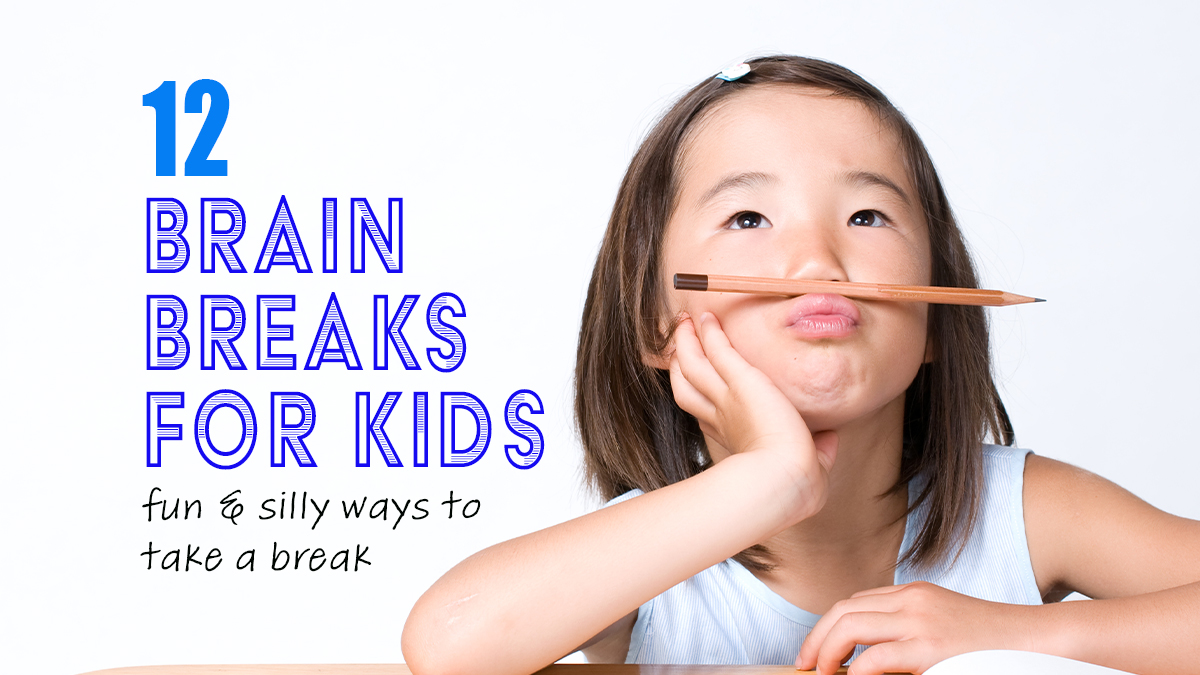
What’s Brain Breaks and How Can They Help Kids?
Brain Breaks are short breaks that young children take at regular intervals. These brain breaks are most commonly performed in an academic or classroom setting, although they can be done in similar learning settings. Most brain breaks range from around 5 to 20 minutes as a general rule, although most people prefer to keep them short and on point. It is best to add a fitness activity as a complement to mental energy for maximum results.
Brain Breaks Benefits to Kids Brain breaks can help children be calmer and more focused, while encouraging physical activity. Kids have a lot of expendable energy. It can also manifest itself at inappropriate times. The brain break is a good option if you have a bunch of unruly kids. You can regain control and refocus the minds of your kids.
Children should feel less distracted and more motivated to complete tasks or work after taking a brain-break. Brain breaks can also be used to reduce stress and improve learning. If used properly, brain breaks can prove to be very beneficial if implemented correctly. The best way to know your kids is by knowing them.
How can you help your brain?
- The atom. There are many variations of this game.
- Silent ball
- Wouldn’t you rather:
- You can dance to the beat.
- These are the tried and true pages for activities.
- Tricks with cards
- Others quiet choices.
- Teaching a new skill
What are Brain Breaks at School?
An activity we call a “brain-break” is anything short that interrupts the lesson and is designed for improving relationships (teacher-student or student-student).
How Do You Play Brain Breaks?
All game materials should be available. The first person to draw a card will choose a task, and the rest of the players must complete it before the timer expires.
.Brain Breaks For Kids